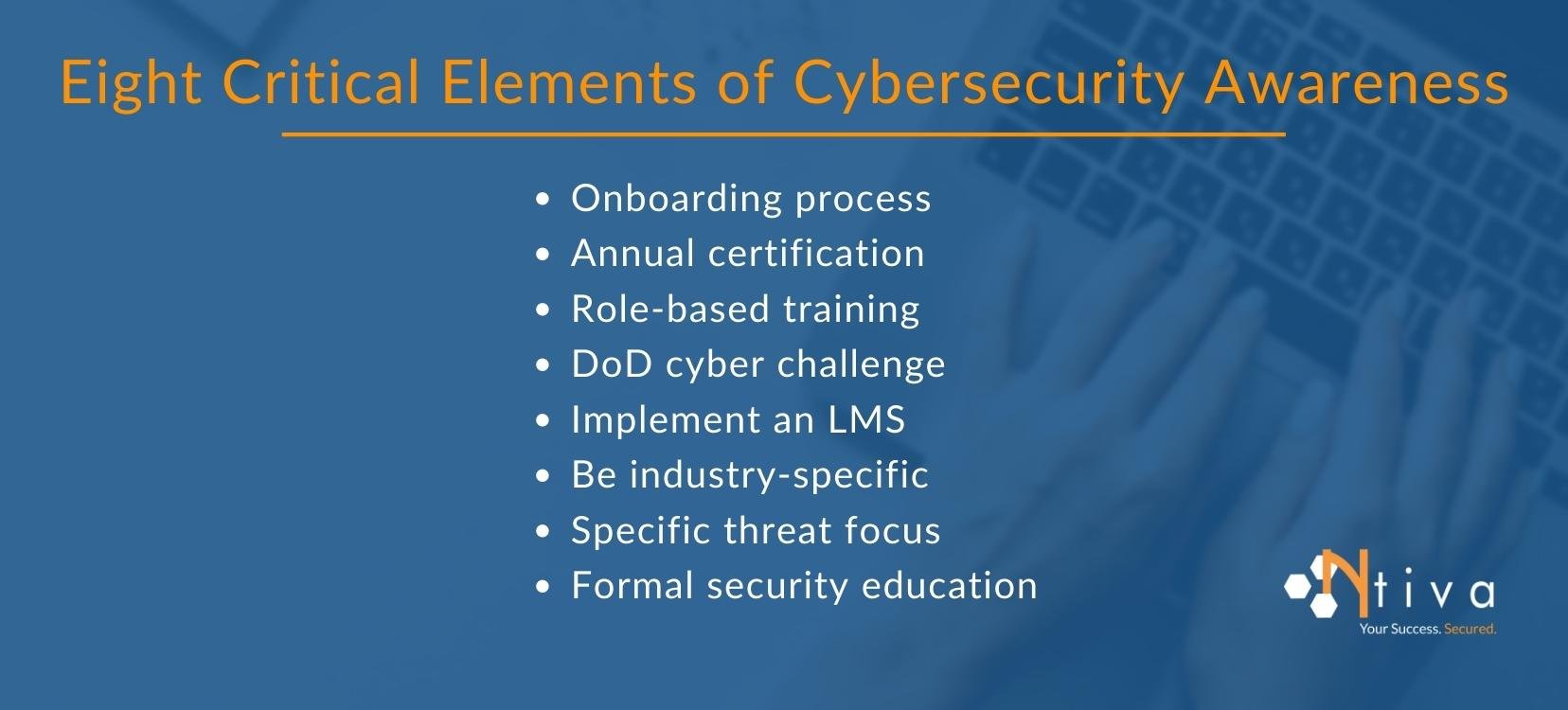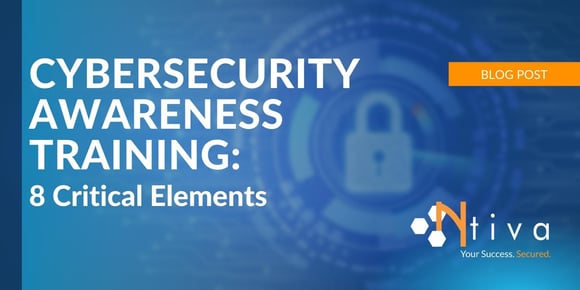Your greatest cybersecurity vulnerability isn’t your hardware. Or your software. It’s your people!
People—executives, managers, team leaders, workers—are the leading cause of data breaches today. If you want to boost your cybersecurity defenses, you'll need to boost the level of cybersecurity awareness throughout your organization.
How? With a robust cybersecurity awareness training program!
Read on to discover our top 8 tips on security training and education to improve awareness among your employees—and to protect your business.
Table of Contents
- Security Awareness vs Security Best Practices
- Start with Onboarding
- Conduct Annual Re-Certification Training
- Conduct Role-Based Training
- Consider Mandating the DoD Cyber Awareness Challenge
- Implement a Learning Management System (LMS)
- Conduct Industry-Specific Training
- Conduct Threat-Specific Training
- Consider Formal Security Education
Security Awareness and Security Best Practices: Know the Difference
Before you begin your journey toward greater cybersecurity awareness, understand the difference between security awareness and security best practices.
- Security awareness focuses on the knowledge and attitude of the people in your organization. This covers everything from physical security to personnel to data security.
- Security best practices are the methods and techniques your community or industry have adopted, and that you should apply within your organization.

Tip 1: Start with Onboarding
Raise awareness about cybersecurity on the first day of employment. Ensure that as part of your standard onboarding, every employee, no matter how senior or junior, and regardless of department, receives training on phishing attacks, removable media, passwords and authentication, working remotely, mobile device security and more.
Raise awareness on Day One and you reduce the likelihood of that employee causing a breach in year one.
Tip 2: Conduct Annual Re-Certification Training
Resilience comes through repetition. So, conduct regular refresher training.
Organizations typically require all employees to re-certify once a year to ensure they still remember how to keep their organization safe from hacking attacks. For some organizations, this re-certification takes place one year after the employee last passed certification. For other organizations, they pick a month and run all employees through the re-certification process during that month.
Before you pick the method that works for you, investigate to see if you are required by legislation or contractual obligations (contracts with federal government agencies, for example) to re-certify your employees according to a different schedule. Otherwise, if your schedule and their schedule aren’t aligned, you will be out of compliance.
Tip 3: Conduct Role-Based Training
Some of your employees are more vulnerable to cyberattacks than others, based on their role within your organization. Cyber criminals most often target c-level executives and their executive assistants, marketing and public relations staff, R&D staff, engineering employees, and accounting and finance employees.
This means you should consider delivering cybersecurity awareness training based on roles. The more vulnerable the role, the more extensive and frequent your training must be.
In many organizations, role-based training is optional. But as your security program matures, consider making this training mandatory. Again, first check to see if government regulations or contractual obligations require you to deliver role-based cybersecurity awareness training.
Tip 4: Consider Mandating the DoD Cyber Awareness Challenge
Some of the most vulnerable information systems in the world are those operated by the U.S. Department of Defense (D0D). So, the DoD has created baseline, mandatory training to influence the behavior of all employees, focusing on actions that authorized users can take to mitigate threats and vulnerabilities to DoD Information Systems. This training is called the Cyber Awareness Challenge. It changes regularly to reflect the latest threats and best practices. Best of all, it’s also free to take.
Tip 5: Implement a Learning Management System (LMS)
To stay on top of your cybersecurity awareness training, you might need an LMS system. A good LMS offers you a large variety of training courses, lets you track employee progress, shows you the amount of time spent in training, and lets you view certifications by employee.
An LMS serves as a repository of employee certification status, so that when an auditor drops in one day to review your level of compliance, you don’t have to scramble and ask employees to produce their certificates. You simply export a record from the LMS that shows all levels of course completion and certification.
Another advantage of an LMS is it helps you see how much your organization and your personnel are focusing on security versus other topics. You can track every user's training across the entire year, and gain some valuable insights, like:
- How often did this person sign into the LMS to take cybersecurity awareness training?
- How often did this team sign in?
- When we look at our anti-phishing awareness program, do we see that a particular department has a higher percentage of staff who click on malicious links than other departments?
- Does the department with the high number of clickers on phishing links spend little time doing awareness training?
Tip 6: Conduct Industry-Specific Cybersecurity Awareness Training
If your organization is in the finance, banking, insurance, health care or government sectors, one-size-fits-all cybersecurity training is probably not going to cut it.
This means you must determine the type of data that people in your industry are responsible for collecting, storing and protecting, and then provide training that addresses the specific cybersecurity needs for your industry. For example, the credit card payment processing industry might require different cybersecurity training than the lending industry. The energy industry might need training around protecting intellectual property while the health care industry will focus on training to protect personal health information.
Fortunately, in many of these types of industries, there are typically well-established cybersecurity training programs available.
Tip 7: Conduct Threat-Specific Training
You should consider not only each employee’s role within your organization, but also the types of threats they are exposed to. If an employee deals all day long with transactions that might involve wire fraud, for example, then you will want to target training that's specific to that role.
Other threats are universal and can strike anybody in your organization, making it vital for all staff to become extremely familiar with how they work and how to spot them. Phishing, for example, is probably the largest threat that you have right now, since phishing is the primary way that hackers deliver ransomware.
If your greatest risk is phishing, deliver some phishing training. If your greatest threat is social engineering, or attacks on unsecured home Wi-Fi connections, or attacks on company-issued phones, focus your cybersecurity awareness training on these threats.
Tip 8: Consider Formal Security Education
Educated employees are safer employees. They create fewer vulnerabilities and expose your networks and data to fewer threat actors.
The best way to train your employees is through certifications and degree-based training, but this can be time consuming, costly and likely impractical. So, consider the many alternatives at your disposal, including:
· Webinars
· Seminars
· One-day certification programs
· Conferences
· Courses, live and remote
· Online training
· College certificate programs
· Self-directed learning
· Instructor-led courses
· Books
· Videos
· Email courses
In the long run, smaller but more frequent training sessions are typically more effective. By giving employees time to digest their learning in bite-sized chunks, they’re more likely to remember the details.
Cybersecurity Awareness Training Is Key to Cyber Resiliency
Running a robust cybersecurity awareness training program takes staff, time, effort, commitment and a financial investment.
But the benefits make it all worthwhile. You raise awareness of your vulnerabilities, reduce your level of exposure to threats, reduce the likelihood of downtime, maintain compliance, and increase the confidence of your customers, suppliers and other stakeholders.
Plus, the investment in cybersecurity awareness training is less than the cost of remediating just one data breach: Just ask any organization that’s been compromised!
If you need to stay aware of all things related to cybersecurity, sign up today for our livestream: Ntiva Live: Cybersecurity for the Rest of Us.

